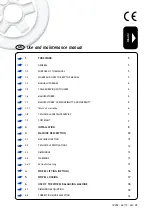
-13 -
Working with the wheel balancer
The main switch is located on the left side of
the machine chassis. A self-test is carried out
during operation. A sequence of numbers
appears on the display and after a few
seconds the display shows
"a
" and "
8.0
.
Clamp the clean wheel onto the clamping
shaft using the correct centering cone.
CAUTION: Even slight dirt on the contact
surfaces of the rim or on the flange of the
wheel balancer can lead to considerable
inaccuracies
during
the
measuring
process.
The quick-release nut is used for even
clamping of the wheel.
The counterposition method is a commonly
used clamping method. Suitable for steel and
alloy rims.
-
Press the selected cone onto the balancing
flange.
-
Place the hub edge on the cone.
CAUTION: The clamping shaft must not
be damaged!
-
Tighten the wheel firmly with the plastic
pressure ring and quick-release nut.
Guide the tip of the distance meter to the rim
flange and read the value directly from the
ruler extension. Press the keys and enter the
read value using the distance key "a+" or "a-
". The left-hand display shows "a", the right-
hand display shows the value entered.
The rim width is determined with the rim width
gauge. Press the keys and enter the desired
value using the eel width keys.
Enter the value for "b+" or "b-". The left display
shows "b", the right display shows the value
entered.





















